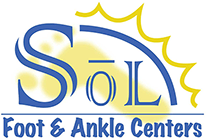 Nobody likes to see their children injured. However, with the ever-increasing involvement of children in organized sports at such younger ages, injuries to the foot and ankle are actually quite common.
Nobody likes to see their children injured. However, with the ever-increasing involvement of children in organized sports at such younger ages, injuries to the foot and ankle are actually quite common.
When you see your child limping (or getting carried!) off the field, it can be difficult and confusing to determine how serious their foot or ankle injury is or whether you will need to go to the doctor.
The best way to gauge the seriousness of an injury is to go through a quick check list.
Your feelings are likely affected by the age and communication level of your child, their desire (or lack of) to continue playing the sport, and how your child typically responds to stress and or painful situations. You also must evaluate how you, as a parent, handle your emotions about seeing your child in discomfort.
The best way to gauge the seriousness of an injury is to have a quick checklist to go through so that your emotions don’t impair your judgment in the heat of the moment. By asking yourself the following three questions you can quickly get a handle on the situation and then decide best how to proceed:
Quick Injury Check List:
- How is the child moving? If they can’t bear any weight or are limping severely on the affected foot even after a few minutes this can be a sign of a more serious injury.
- How severe is the injury? Bruising, swelling and redness are the most obvious signs of a significant problem. If any of these appears within minutes of the injury you should raise your level of concern.
- How did the injury occur? Injuries caused by a direct blow are usually not as severe as injuries caused by twisting or torquing motions such as ankle sprains.
You never want to ignore a serious injury, especially one suffered by a child.
As soon as you have assessed the answers to these questions you will be able answer the most important question; is this going to require a call the doctor or a trip to the emergency room? 
You never want to ignore a serious injury, especially one suffered by a child. You’re dealing with growing bones that have injury-susceptible growth plates as well as muscles, tendons and ligaments that are not yet fully developed. However, if after quick assessment the answers all tell you that this may be something minor, then you can probably observe for a while before making a final decision.
To make things even simpler, there is one sign you can look for that, if present, almost always tells you that the injury is potentially serious: bruising. The “black and blue” of a bruise represents bleeding under the skin. The bleeding means that there is some type of tissue damage, which could be to bone, tendon, muscle or ligament. It may also be a simple “bruise” of the soft tissue just under the skin.
If you see bruising or swelling within 30 minutes of an injury then a doctor visit is recommended.
If you see bruising within 30 minutes of a foot or ankle injury injury, especially if it is accompanied by significant swelling, then some type of doctor’s visit is definitely recommended. The injury could still be serious even without immediate bruising, but bruising is a definite sign of injured tissue and an x-ray should be taken. If, even after making your quick assessment, you’re still not sure what to do, then definitely err on the side of caution and have your child evaluated by a foot and ankle specialist.
For foot and ankle injuries the professional you seek should always be podiatrist.
Even if the emergency room doctor has said, “It’s nothing serious,” you still want to have the opinion of a specialist. We have seen too many serious injuries that were under-treated and became chronic problems.
The final thing to consider when it comes to your child’s foot injury is to trust your own instincts. Don’t listen to the coach, the pseudo-athletic trainer on the bench, or other parents. Go through your quick assessment of physical signs and symptoms and then you will take the action that is best for you and your child both physically and emotionally.
Listen to your own instincts.
If your child is suffering from a foot or ankle injury and you would like more information or would like to schedule an appointment with one of our experienced podiatrists. Call 562-433-0478.

